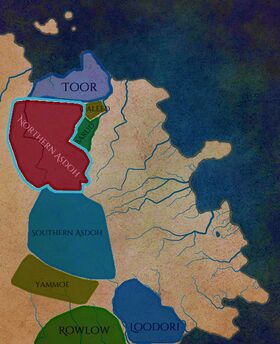State of Asdoh
| Asdoh | |
| Political details | |
|---|---|
| Capital | Estonoh |
| Government | monarchy |
| Language | Asdoh |
| Religion | Xaewoon |
| Historical details | |
| Established | 16th CFR |
| Disestablished | 180s SR |
Asdoh /'yɑsdə/ was the first documented state of the Dawn settlers that largely retained elements of the Western Dantrian culture, such as architecture and government. Reaching it's peak at the end of the first revolution, Asdoh began to fall into decline in the second revolution. Losing population to Yammoe, Loodori and even Barud, which itself was struggling, Asdoh was eventually abolished by Stogen in the 2nd CSR and broken down into individual city states, most of which have been then deserted. Ernele is the only surviving city of Asdoh, retaining some of the ancient buildings.
Asdoh's sophisticated governance, economics, Western Dantrian cultural heritage and the fact that so much of its brilliance was lost, turned it into a legendary country, highly mythologized and revered by many as the greatest Tarnarian civilization. The emergence of the Mōroh philosophy in the 2nd CSR had treated Asdoh as the biggest religious mistake of the peoples of Tarnaria, condemning the sedentary form of life, which was understood and the refusal to follow one's path.
The Asdoh vs Mōroh debate is still prevalent in Tarnaria and is considered the main ideological divide.
History
Technology
Infrastructure
Asdoh was notable for building wide and flat roads out of red stone, known as "red roads". This technology is believed to have originated in Western Dantria. It was largely lost after the dissolution of the State of Asdoh, although the Empire of Barud used a similar technique. It was equally lost when Barud was overrun by Stogen in the 2nd CSR.
These roads allowed for much faster travel and communication, which also led to a wider distribution of cities and settlements, since it was possible to reach larger cities and water supplies from farther away.
